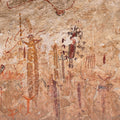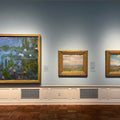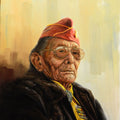John Nieto documentary reveals the man behind the paintings
By Medicine Man Gallery on

John Nieto triptych inside New Mexico State Capitol building
John Nieto wasn’t solely responsible for sparking my interest in Native American contemporary art, although his work played a critical role. During my first ever visit to Santa Fe, I came across his Fauvist inspired paintings at Ventana Fine Art on Canyon Road. I was immediately taken by the electric color and imagery.
A day or two later I found his massive triptych on a tour of the New Mexico State Capitol. Then, flying home, his Buffalo Dancer caught my eye prominently displayed in the Albuquerque Sunport airport.
His work was an awakening for me, just two or three years into my “art life,” diving into this world previously unknown to me, in search of I didn’t know what after hitting a professional midlife crisis 20 years on in my sports media career.
Nieto (1936 – 2018) painted a Native perspective brought modern. Having no background in the arts, let alone Indigenous art, I can’t even recall now if I was then aware such a thing existed. I sure do now as contemporary Native American art is my favorite of all genres and the one I write most about.
John Nieto lies at the core of that origin story. Needless to say, I was excited to find that a documentary sharing Nieto’s life and work debuted on Amazon Prime, Monday, February 6. I began streaming “John Nieto: An American Spirit Walk” ($2.99 rental) minutes after receiving the news from a Nieto-family owned Instagram account.
Through interviews from Nieto’s wife Renay, one of his son’s, Anaya, siblings, gallerists, collectors, colleagues and professional experts, along with archival interviews with the artist, Nieto takes on three-dimensions, becoming a man, a person, not merely the producer of his paintings. Viewers learn how he was one of 14 siblings. That his father was a Methodist minister which required the family move every year. Every single year. Nieto attended 12 different schools from grade school through high school.
One sister remembers how “Johnny” would draw in the air with his finger, even as a young child. Nieto planned on becoming a professional artist from 6-years-old – a painter to be exact. He was born with a talent for it. Art came easy to John Nieto from his first watercolor in first grade to drawings and paintings in middle school which astonished his teachers for their proficiency. Music came easy to him as well and he could play multiple instruments by ear along.
The Hard Times
“An American Spirit Walk” reveals Nieto’s hardships as well. He went through a period of alcoholism. He was a bad drunk. Violent. Blackout.
“The hardest and most painful thing in John’s whole life,” however, according to Renay, was when his Indigeneity was questioned. This reached its peak with passage of an updated Indian Arts and Crafts Act in 1990. This law stipulates that only artwork produced by enrolled members of federally or state recognized tribes can marketed or presented as “Native American.” It’s a well-meaning and necessary law passed to fight the flood of factory-made knockoffs and fakes which poison the Native art market. The law protects artists and consumers alike.
There’s one catch, though. Native artists like Nieto who have never been enrolled members of a tribe for one reason or another. Both of Nieto’s parents were of mixed Indigenous and Hispanic ancestry. When writing about Nieto, I’ve found it frustrating not being able to more certainly attach a tribal affiliation to his name as most Native artists prefer when introducing them in print.
My one complaint with “An American Spirit Walk” is the abrupt treatment this aspect of Nieto’s life was given. If this was, in fact, “the worst thing that ever happened to him,” in the words of his wife, one for which the documentary mentions his life was threatened, more attention than a couple minutes should have been given to it.
Why didn’t Nieto enroll as a tribal member? Did he ever attempt to? Which tribes can he trace his heritage back to? The considerable focus on Native American imagery in his artwork obviously indicates Indigeneity was important to him, by not offering more detail explaining Nieto’s perspective on this question, the documentary leaves one considerable hole in our understanding of him.
Nieto Color
“John used color in a way that no one had seen before,” art historian Wolfgang Mabry is quoted in the documentary. “People would go into the John Nieto room (in a gallery) and you would see their eyes – even if they knew his work already – their jaw would drop, they would just be stunned.”
Nieto’s work will always most prominently be associated with his use of color. Rich, saturated, fluorescent, non-representational color.
“When you think of John Nieto, you think of color, and that’s how he saw the world,” his son Anaya said. “It wasn’t black and white for him, it was exciting, it was fun, it was full of energy and that’s really what drove him into that studio every day.”
Remarkable video footage of Nieto in his studio, surrounded by oil paints, working the canvas, provides insight into his brilliant mind for color. He found the Fauves, French for “wild beasts,” so named by a Parisian art critic in 1905 who was gob smacked by a nascent group of artists garish use of color. The group included a young Henri Matisse. He was further captivated by the color choices of Paul Gauguin and Wassily Kandinsky.

John Nieto, Coyote Medicine, 1992. Acrylic on canvas. Collection of the James Museum of Western and Wildlife Art
He spent a month and a half in Paris after college and six years in the Army reserves. He visited the Louvre daily, staying for hours. He packed a lunch. He went looking to find himself as an artist, seeking direction in his career. What Nieto was looking for in Paris he found almost immediately upon returning to the States during a visit to the Mescalero Apache reservation in south central New Mexico with one of his grandmothers. They watched Mountain Spirit Dancers during an all-day ceremony.
“Johnny, do you think you could paint my people,” Nieto recalled his grandmother asking at one point during the ceremony in a recorded interview shared in the documentary. “I got chills. I’m just back from Paris, on a vision quest trying to find out about myself and about what direction to take in my art, and here was the answer, right from grandma.”
The request sent him on an artistic journey from which he would seldom deviate.
The Comeback
“An American Spirit Walk” concludes recalling Nieto’s improbable recovery from a stroke in 2002 which left him incapacitated for over three years. He couldn’t walk. He couldn’t talk. Painting was out of the question. So out of the question that family members closed up his studio, packed away or discarded all of his materials and supplies, and resigned themselves to having seen the last John Nieto painting.
The artist did too, he wanted the studio closed as well, the sight of it was too painful.
Despite medical odds giving him less than a 10% chance, Nieto suddenly, miraculously, inexplicably bounced back. As if he’d never stopped. He resumed his career without missing a beat, not one ounce of his skill or flare for color diminished. He would continue producing his vivid, expressive, spiritual depictions of Native people and wildlife through his last days on earth.
Nieto died in July 2018. My Santa Fe trip introducing me to his work occurred the very next month. In my mind, in the minds of his family and friends and collectors, John Nieto will always be with us.

John Nieto, Taos Buffalo, 1991. Acrylic on Cavans. James Museum of Western and Wildlife Art



